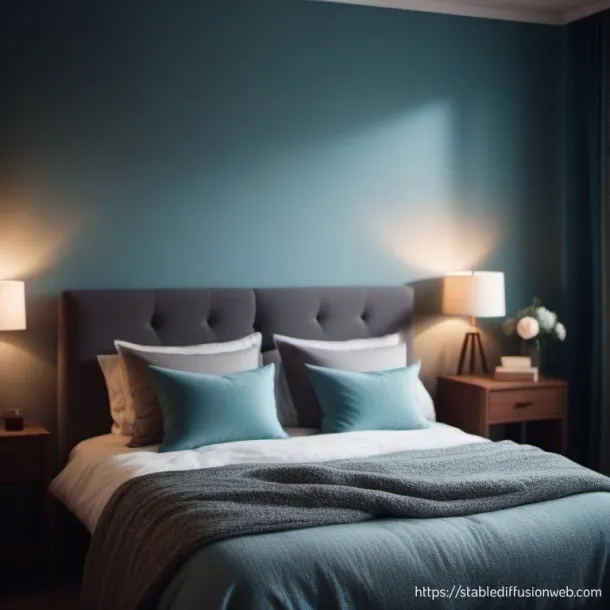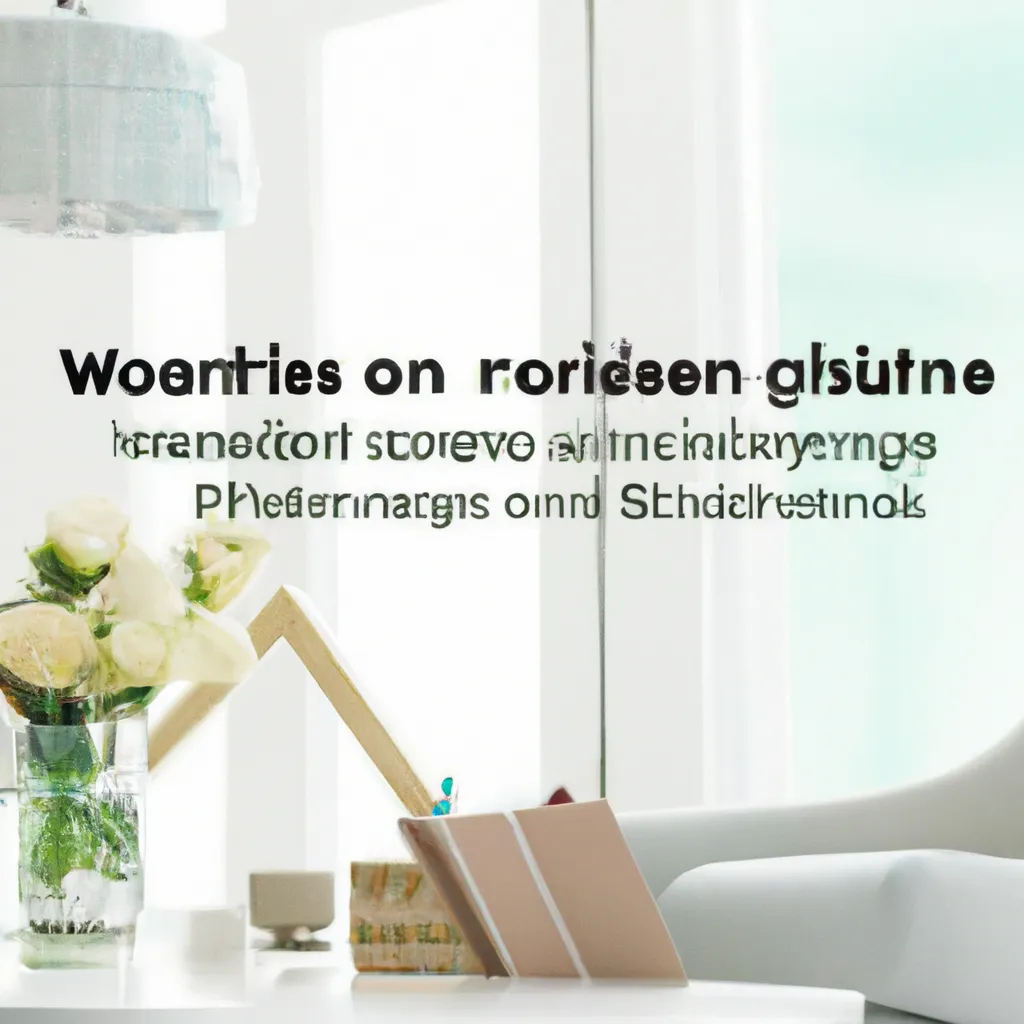Creating a Calming Atmosphere with Relaxing Colors in Your Home
Immerse yourself in a world of tranquility by infusing your home with the captivating power of relaxing colors.
According to color psychologists, the strategic use of soothing hues can be a game-changer when it comes to reducing stress and creating a truly calming atmosphere.
Picture a serene landscape where blues and greens reign supreme, with these natural shades effortlessly conjuring feelings of peace and restoration.
Additionally, neutrals like sandy tones and twilight blue have emerged as popular choices for those seeking a tranquil color scheme that lulls the senses.
Soft warm shades and gentle pastels also hold a special place in the art of relaxation, while it’s best to steer clear of bright and intense colors that may disrupt the serene ambiance.
Take a deep breath, as we explore how the thoughtful use of colors can transform your living space into a haven of tranquility.

This image is property of cdn.mos.cms.futurecdn.net.
Choosing the Right Colors
When it comes to creating a calming and stress-free environment in your home, choosing the right colors is key.
Color psychology plays a crucial role in our emotions and can greatly impact how we feel in a space. By understanding the psychological effects of different colors, you can make informed choices that promote relaxation and tranquility.
Understanding color psychology
Color psychology is the study of how colors can affect our emotions, behaviors, and overall mood. Different colors have the power to evoke specific feelings and can significantly impact our well-being.
When it comes to creating a relaxing atmosphere in your home, it’s important to choose colors that promote a sense of calmness and serenity.
Using blues and greens
If you’re aiming to create a soothing and tranquil environment, incorporating colors that are reminiscent of nature is a great choice. Blues and greens, in particular, have been found to be the most relaxing colors.
These colors are often associated with water, sky, and lush forests, which evoke feelings of calmness, peace, and restoration.
Consider using shades of sky blue, soft aqua, or calming seafoam green in your space. These colors can instantly create a serene and relaxing atmosphere, making them perfect for bedrooms, living rooms, and any space where you want to unwind and destress.
Incorporating neutrals
Neutrals are another excellent option for creating a calming color scheme in your home. Colors such as sandy tones, earthy beiges, and soothing grays can provide a sense of balance and tranquility to a space.
These neutral hues can be used as a base color to create a calm backdrop, allowing you to incorporate other soothing shades as accents.
Twilight blue, a soft and muted shade of blue, is also a popular choice for creating a relaxing atmosphere. This serene color resembles the sky at dusk and can help create a sense of calmness and relaxation in any room.
Exploring soft warm shades and pastels
In addition to blues, greens, and neutrals, exploring soft warm shades and pastels can also contribute to a calming and relaxing space.
Soft pinks, lavender, and pale yellows can create a peaceful and serene ambiance, making them perfect for bedrooms and meditation spaces.
These gentle pastel colors can evoke a sense of tranquility and can help promote a peaceful atmosphere. Combining these shades with blues and greens can create a harmonious color palette that induces relaxation and tranquility in your home.
Avoiding Bright and Intense Colors
While some colors can promote a calming atmosphere, others can have the opposite effect and evoke feelings of stress and agitation. Bright and intense colors, in particular, should be avoided when aiming for a tranquil and peaceful environment.
Understanding the impact of bright colors
Bright colors, such as vibrant reds, oranges, and yellows, have been found to stimulate the senses and create a sense of energy and excitement.
While these colors can be invigorating in certain spaces, they are not conducive to relaxation and stress reduction. Bright colors can be overwhelming and can prevent total relaxation, so it’s best to use them sparingly or as accents in a calming color scheme.
Identifying intense color tones
Intense color tones, regardless of their saturation level, can also have a stimulating effect on our emotions. Colors such as bold purples, deep reds, and vibrant oranges can create a sense of intensity and even restlessness.
These colors can increase heart rate and blood pressure, making them unsuitable for creating a calming and stress-free environment.
Avoiding colors that evoke stress
In order to maintain a relaxing atmosphere in your home, it’s important to avoid colors that evoke stress and tension.
While individual preferences may vary, it’s generally recommended to steer clear of shades such as bright red, intense orange, and aggressive shades of yellow. Instead, opt for softer and more muted versions of these colors to maintain a tranquil ambiance.
Creating a Relaxing Color Scheme
Now that you understand the basics of color psychology and the impact of different colors, it’s time to create a calming color scheme for your home. There are several techniques and approaches you can use to achieve a relaxing atmosphere.
Using a monochromatic color scheme
One effective way to create a sense of serenity and calmness is by using a monochromatic color scheme. A monochromatic color scheme consists of using varying shades and tints of a single color.
This approach creates a visually cohesive and harmonious space, promoting a sense of relaxation and balance.
Choose a color that resonates with you and use different shades of that color throughout your space. For example, if you choose blue as your base color, incorporate lighter and darker shades of blue in your furniture, accessories, and wall paint.
This creates a serene and visually appealing environment, perfect for unwinding after a long day.
Combining complementary colors
Another way to create a relaxing color scheme is by combining complementary colors. Complementary colors are located opposite each other on the color wheel and create a visually striking and balanced combination.
When used in moderation, complementary colors can create a vibrant yet calming atmosphere.
Pairing cool colors like blues and greens with warm colors like oranges and yellows can create a sense of harmony and balance.
Consider using a subdued shade of orange as an accent color in a predominantly blue room, or a soft yellow as an accent in a green-themed space. This creates a visually interesting and relaxing color scheme.
Exploring analogous color palettes
Analogous color palettes consist of using colors that are adjacent to each other on the color wheel. This approach creates a sense of unity and cohesiveness in a space. Analogous color schemes can be particularly soothing and can evoke a sense of tranquility and relaxation.
For example, using shades of blue, green, and purple creates a calming and harmonious color palette. Consider using a combination of light blue, sea green, and lavender in your space to create a visually soothing and serene environment.
Incorporating neutral accents
To maintain a sense of calmness and tranquility within your color scheme, it’s important to incorporate neutral accents. Neutral colors such as whites, grays, and beiges can help balance out the more vibrant and saturated colors in your space.
Consider incorporating neutral accents through your furniture, accessories, and wall paint. This allows the calming colors to shine while providing a sense of grounding and stability. Neutral accents also create a visually appealing and timeless look that promotes relaxation and serenity.
Applying Colors to Different Spaces
Now that you have a better understanding of how to create a calming color scheme, it’s time to explore how to apply these principles to different spaces in your home. Each space has its own unique requirements and possibilities, so it’s important to consider the specific needs and functions of each area.
Creating a calming bedroom
The bedroom is a space where relaxation and tranquility are of utmost importance. When selecting colors for your bedroom, it’s essential to choose hues that promote restful sleep and a sense of peace.
Start by selecting a calming base color, such as soft blue or lavender, to create a serene backdrop. Incorporate complementary colors or analogous shades to add depth and interest to the space. Consider using neutral accents to create a soothing and balanced atmosphere.
Designing a peaceful living room
The living room is often the heart of the home, where family and friends gather to relax and unwind. Creating a peaceful and inviting atmosphere in this space is essential for promoting relaxation and well-being.
Choose a calming color palette that aligns with the overall mood you want to create. Consider incorporating blues and greens as the dominant colors to create a soothing and calm environment. Use neutral accents and warm shades sparingly to add depth and visual interest.
Relaxing colors for the bathroom
The bathroom is a space where you can escape and indulge in self-care and relaxation. Creating a calming color scheme in the bathroom can enhance the overall spa-like experience.
Consider using soft shades of blue or green to create a sense of tranquility and cleanliness. Incorporate neutral accents and textures to create a visually pleasing and calming environment.
Add luxurious touches, such as scented candles and soft towels in complementary colors, to complete the relaxing ambiance.
Choosing colors for a tranquil office
Creating a tranquil office space is essential for maintaining focus and promoting productivity. By incorporating calming colors into your office, you can create an environment that supports concentration and reduces stress.
Consider using a monochromatic color scheme with a calming base color, such as light gray or pale blue.

Add accents of green or soft pastel colors to create a visually appealing and peaceful space. Avoid using bright or intense colors, which can be distracting and increase stress levels.
See also The Comfort and Convenience of Wall Beds: Why You Should Consider a Murphy Bed for Your Home
Implementing Color Techniques
In addition to selecting the right colors for your space, there are various color techniques you can implement to further enhance the calming atmosphere. These techniques can help create a visually appealing and soothing environment.
Using color blocking
Color blocking is a technique that involves using large blocks of color to create a visually striking and modern look. This technique can be used to create a focal point or to divide a space into different zones.
Consider using color blocking in your space to create a sense of balance and visual interest. Use calming colors as the main blocks, with neutral or complementary colors as accents.
This technique adds a touch of creativity and modernity to your space while maintaining a calming atmosphere.
Creating an accent wall
An accent wall is a great way to incorporate color into your space without overwhelming the entire room. This technique involves painting or wallpapering a single wall in a vibrant or contrasting color to create a focal point.
Choose a calming color that complements the overall color scheme of the room. Consider using a soft shade of blue or green to create a visually striking yet tranquil accent wall. This technique can add depth and interest to your space while maintaining a relaxing ambiance.
Incorporating natural light
Natural light has a significant impact on our mood and can greatly enhance a calming color scheme. Maximizing the amount of natural light in your space can create a bright and inviting atmosphere.
Consider using light-filtering window treatments, such as sheer curtains or blinds, to allow natural light to enter your space while maintaining privacy. Rearrange furniture and accessories to optimize the use of natural light and create a warm and inviting ambiance.
Using soft lighting options
In addition to natural light, incorporating soft lighting options can further enhance the relaxing atmosphere in your home. Avoid bright and intense overhead lighting, which can be harsh and create a sense of alertness.
Opt for soft, warm lighting options such as table lamps, floor lamps, and string lights. These lighting fixtures create a cozy and inviting atmosphere, perfect for unwinding and relaxation. Use dimmers or warm light bulbs to create a softer and more soothing ambiance.
Color Psychology Tips
When selecting colors for your home, it’s important to consider your personal preferences and experiences.
Color psychology is not a one-size-fits-all approach, and what may be relaxing for one person may not have the same effect on another. Here are a few tips to help you incorporate color psychology into your home in a personal and meaningful way.
Evaluating personal color preferences
Take some time to evaluate your personal color preferences. Consider the colors that make you feel calm, relaxed, and at ease. Pay attention to the colors that evoke positive emotions and those that may trigger stress or discomfort.
This self-awareness will help guide your color choices and create a space that resonates with you.
Incorporating personal experiences and memories
Colors can evoke powerful emotions and memories. Consider incorporating colors that remind you of a calming experience or a happy memory. For example, if you have fond memories of spending summers by the ocean, incorporating shades of blue and green can create a sense of nostalgia and relaxation.
Considering cultural influences
Colors can have different meanings and associations in different cultures. Take into consideration your cultural background and any specific cultural associations with colors. Incorporate colors that align with your cultural traditions and values as a way to create a sense of familiarity and comfort in your space.
Experimenting with color samples
Before committing to a color scheme, experiment with color samples in your space. Paint small sections of your walls or hang fabric swatches to see how the colors interact with the lighting and other elements in the room. This experimentation allows you to visually assess the impact of the colors before making a final decision.
Accessorizing with Relaxing Colors
In addition to selecting the right colors for your walls and furniture, accessorizing with relaxing colors can further enhance the calming atmosphere in your home. Here are a few key areas where you can incorporate calming colors through furniture and decor.
Incorporating furniture and decor
Choose furniture and decor pieces in calming colors to complement your overall color scheme. Opt for upholstery in soft blues, greens, or neutrals to create a soothing and inviting atmosphere. Incorporate natural materials, such as wooden furniture or woven textiles, to enhance a sense of tranquility and connection to nature.
Choosing calming bedding
Your bedroom should be a sanctuary for relaxation and restful sleep. Choose bedding in calming colors, such as soft blues, greens, or gentle pastels, to create a serene and inviting atmosphere. Opt for natural fibers, such as cotton or linen, for added comfort and breathability.

Using soothing window treatments
Window treatments can greatly impact the overall mood of a space. Choose window curtains or blinds in calming colors to enhance the relaxing atmosphere in your home. Sheer curtains in soft blues or greens can filter natural light and create a soothing ambiance. Consider layering curtains to add depth and visual interest.
Adding greenery and natural elements
Incorporating greenery and natural elements into your space can greatly enhance a calming color scheme. Add indoor plants in soothing shades of green to create a connection to nature and promote relaxation. Place a vase of fresh flowers in soft pastels to add a touch of color and a sense of freshness.
Applying Colors to Different Styles
Creating a calming atmosphere doesn’t mean you have to sacrifice your personal style. Whether you prefer a modern aesthetic, a traditional home, a minimalist approach, or a bohemian style, there are ways to incorporate relaxing colors into any style.
Creating a calming atmosphere in a modern style
Incorporating a calming color scheme in a modern style is all about simplicity and minimalism. Choose a neutral base color, such as white or gray, and use pops of calming colors as accents. Opt for clean lines and minimalistic furniture to create a sense of tranquility and balance.
Incorporating relaxing colors in a traditional home
Traditionally styled homes often feature warm and inviting colors. To create a calming atmosphere in a traditional home, choose soft and muted shades of blues and greens. Pair these colors with rich and earthy tones to create a sense of comfort and warmth. Incorporate classic furniture pieces and layered textures to enhance the traditional aesthetic.
Using colors for a minimalist aesthetic
Minimalist styles focus on simplicity, clean lines, and a clutter-free environment. To create a calming color scheme in a minimalist space, opt for a monochromatic color palette.
Choose a soft and calming base color, such as pale gray or light beige, and incorporate tonal variations for added depth. Keep accessories to a minimum and embrace negative space to enhance the peaceful ambiance.

Relaxing color choices for a bohemian style
Bohemian styles are known for their eclectic and vibrant nature. To create a calming bohemian space, choose colors that are reminiscent of nature, such as warm oranges, earthy browns, and deep greens.
Combine these colors with natural materials, such as rattan or macramé, to create a sense of tranquility and connection to the earth.
Maintaining a Calming Atmosphere
Creating a calming atmosphere in your home is an ongoing process. It’s important to consistently maintain and refresh your color scheme to ensure that it continues to promote relaxation and well-being.
Here are a few key factors to consider when maintaining a calming atmosphere.
Using color accents in organization
Incorporate calming colors into your organizational systems to create a sense of order and tranquility. Use bins, storage boxes, and file folders in calming colors to create a visually appealing and calming environment.
This will not only help you stay organized but also enhance the overall aesthetic of your space.
Keeping colors consistent throughout the home
Maintain consistency in your color scheme throughout your home to create a cohesive and calming atmosphere.
Consider how each room connects to the next and choose colors that flow seamlessly from one space to another. This consistency will create a sense of harmony and tranquility throughout your home.
Refreshing the color scheme periodically
Periodically refreshing your color scheme can help prevent monotony and promote a sense of novelty. Consider updating your accent colors or adding in new accessories to create visual interest.
This will keep your space feeling fresh and inviting, leading to continued relaxation and enjoyment.
Taking care of the emotional impact of colors
Colors can have a profound impact on our emotions and well-being. Regularly assess the emotional impact of the colors in your space and make adjustments as needed. Pay attention to how the colors make you feel and make changes accordingly.
Creating a calming and stress-free environment in your home is essential for relaxation and overall well-being. By understanding color psychology and using the right colors, you can transform your home into a haven of tranquility.
Incorporate blues, greens, neutrals, and soft pastels to evoke a sense of calmness and create a visually appealing and calming space.
Consider the specific needs of different rooms and experiment with color techniques to enhance the overall ambiance. Remember to regularly assess and refresh your color scheme to maintain a sense of novelty and prevent monotony.
By incorporating relaxing colors into your home, you can create a serene and inviting atmosphere that promotes relaxation and peace.
